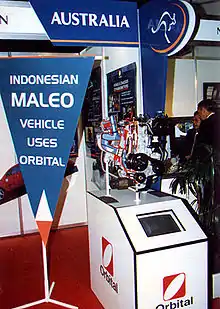
The Sarich orbital engine is a type of internal combustion engine, invented in 1972 by Ralph Sarich, an engineer from Perth, Australia, which features orbital rather than reciprocating motion of its central piston. It differs from the conceptually similar Wankel engine by using a generally prismatic shaped piston that orbits the axis of the engine, without rotation, rather than the rotating trilobular rotor of the Wankel.
Overview
The engine promised to be about one third the size and weight of conventional piston engines due to the compact arrangement of the combustion chambers. Another advantage is that there is no high-speed contact area with the engine walls, unlike in the Wankel engine in which edge wear is a problem. However, the combustion chambers are divided by vanes which do have contact with both the walls and the orbiting piston and are more difficult to seal due to the eight corners of the combustion chamber.[1]
In the patent, the engine is described as two stroke internal combustion engine,[2] but the patent claims that with a different valve mechanism it could be used as a four stroke engine.[2] However most of the development work was done on four stroke versions with both poppet and disk valve arrangements. A supercharger is required if operated in two stroke mode since crankcase pumping can't be used to charge the combustion chamber.
Interestingly, in his seminal book [3] researching and documenting all the possible ways to create a rotary piston displacer, Felix Wankel shows the orbiting piston and reciprocating vane mechanism used in the orbital engine.
Research and Development
The Orbital Engine Company, with funding from partner BHP and Federal Government R&D grants,[4] worked on the concept from 1972 until 1983 and had a 3.5L four stroke engine performing as well as the similar petrol car engines of the day at typical road load conditions. A technical paper[5] was presented to the Society of Automotive Engineers in 1982, and is now part of their historic transaction collection.
A major reason for the good performance of this engine was the development of a unique and patented injection system directed into the combustion chamber which created a stratified charge combustion process.
Several auto makers from around the world showed great interest in the engine, however it was realised that there was still at least $100 million of development work required to commercialise the engine and the funding sources decided this was not a sound investment. Instead it was realised the same injection and combustion system could be adapted onto existing two and four stroke petrol engines and this work become the future of the company, being called the Orbital Combustion Process.[6]
Technical problems
The orbital engine has two of fundamental design issues, which also plague the Wankel engine:
- Large surface to volume ratio combustion chamber which leads to larger combustion chamber heat losses and so loss of power, which can be greatly reduced using stratified combustion;
- Long sealing paths and multiple corner seals which mean it is harder to contain the chamber gases and so there is some loss of pressure and thus power.
Drawings
Some conceptual sketches from the engine's patent:
 perspective view with the exhaust end cover and chamber end plates removed
perspective view with the exhaust end cover and chamber end plates removed as before but with the vane and cam member also removed
as before but with the vane and cam member also removed
See also
References
- ↑ Philippine Technology Journal. Vol. 22–23. Science and Technology Information Institute. 1997. p. 17.
While the Wankel engine rotor has line contact with the internal surface of the housing, the concentric rotary vane internal combustion engine rotor has plane contact with the cylinder. Wankel engine is basically an orbital engine because its ...
- 1 2 "Rotary motor".
- ↑ Wankel, Felix (1965). Rotary Piston Machines. London: Iliffe Books Ltd. ISBN 0592006166.
- ↑ Louise Fleming (2004). Excel HSC Business Studies. Pascal Press. p. 59. ISBN 978-1-74125-071-8.
Another disaster was the Federal Government doling out funds to assist Ralph Sarich develop his revolutionary orbital engine. In 1972, he won an inventors' competition and a few years later he floated the company on the stock exchange.
- ↑ Ewing, Peter (1 February 1982). "The Orbital Engine". SAE Technical Paper Series. Warrendale, PA: SAE International. 1. doi:10.4271/820348.
- ↑ John Ettlie (7 June 2007). Managing Innovation. Routledge. p. 204. ISBN 978-1-136-38386-1.
Direct Injection: The Orbital Combustion Process An Australian company named Orbital Engine started working on cleaner burning two-stroke engines in the 1980s. The company developed a unique pump for direct injection systems, and at ...